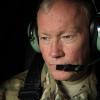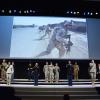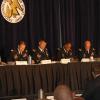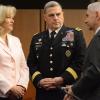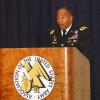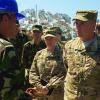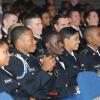Editor’s note: The Senate has confirmed the nomination of Gen. Joseph F. Dunford Jr., former commandant of the Marine Corps, to be the 19th chairman of the Joint Chiefs of Staff. The following story is based on Gen. Martin E. Dempsey’s thoughts following his four years of service as chairman.)In the world of political-military affairs, Army Gen. Martin E. Dempsey likes to say that he is "the dash."The dash is not the name of some superhero. It is the punctuation mark found between "political" and "military" when both factors exist in a given situation.The chairman of the Joint Chiefs of Staff...
"Win in a Complex World," the theme of the Association of the United States Army’s 2015 Annual Meeting and Exposition, Oct. 12 – 14, will set the tone for speeches, industry and military exhibits, and special presentations from senior Defense Department and Army leaders on subjects relating to today’s Army and the Army of the future.The AUSA meeting – A Professional Development Forum – will focus on panel discussions; Contemporary Military Forums; Military Family Forums; and special multimedia presentations and educational workshops that reinforce, examine and showcase the Army – the...
The Army needs a mission command network that is adaptable, secure, and intuitive regardless of user or location, said a panel of experts at AUSA’s Institute of Land Warfare Hot Topic Forum on Army networks."A complex world presents conditions where the threat – the enemy – is becoming increasingly capable and elusive," Brig Gen. John A. George, director of capabilities development for the Army Capabilities Integration Center, said.In complex environments, George said commanders face four primary challenges to mission command: understanding the environment, executing the role of command...
Once again, Congress has left the building.Lawmakers skipped town for the August recess without passing legislation that would fund the government past the Oct. 1 deadline.By blocking the defense spending bill on June 18, Senate Democrats fulfilled their promise to bottle up the appropriations process until the Republicans start budget negotiations to end sequestration once and for all.Before they left town, members of Congress on both sides of the aisle were buzzing with talk of another government shutdown.Could it really happen again?Yes, according to Congressional leaders.Democrats are...
Like fighting fire with fire, the Army is preparing to face networked enemies with its own secure, robust, integrated and global network systems, the Army vice chief of staff Gen. Daniel B. Allyn said recently.Speaking at an Association of the U.S. Army Hot Topic Forum on Army networks, Allyn said, "The Army operating concept recognizes that our Army will face networked enemies in the future – transnational terrorist networks and nation states, networked with guerilla and insurgent organizations, all leveraging physical and cyber networks to attack and degrade our systems."It will take a...
(Editor’s note: On Aug. 5, the Senate confirmed the nomination of Gen. Mark A. Milley to be the 39th Army chief of staff. The following story is a report on Milley’s testimony before the Senate Armed Services Committee as part of the nomination process. )The Army is forced to cut its size because limited funds make it impossible to balance force size with modernization needs and combat readiness, Gen. Mark A. Milley said July 21 as the Senate considered his nomination to be the next Army chief of staff.Milley, nominated to succeed Gen. Raymond T. Odierno as the Army’s top uniformed officer...
he Joint Information Environment, or JIE, will be the future network foundation for all services of the U.S. military, the Army’s chief information officer said."Right now, we have too many disparate networks, we have too many vulnerabilities for our adversaries to exploit," Lt. Gen. Robert Ferrell said, speaking during the Association of the United States Army’s Hot Topic forum on Army Networks in July."The JIE will be a single, joint network," he said. "It’s one shared infrastructure, one standard."Ferrell said the JIE will allow uninterrupted mission command with all of the Department of...
The top U.S. Army commander in Europe does not think it’s likely to get more soldiers permanently based, so his short-term goal is making 30,000 troops look like 300,000.Lt. Gen. Ben Hodges, U.S. Army Europe commanding general, said efforts are the result of Russia’s aggression in Ukraine changing the security environment, with all 28 NATO nations aligned in opposition to the annexation of Crimea and other moves.Speaking at a breakfast hosted by the Association of the U.S. Army’s Institute of Land Warfare, Hodges said, "I don’t anticipate Russia intends to take the rest of Ukraine."Adding...
The downward trend of African-American officers in the branches that have the best track record of producing our Army’s most senior leaders is alarming, bewildering and disappointing. We revel in the success of Gens. Colin L. Powell, Lloyd J. Austin III and Vincent K. Brooks. How do we build and sustain the bench behind them?The bench is bare. Black battalion and brigade commanders are scarce in our fighting divisions—the typical gateway jobs to be competitive for general officer promotion. Our Army works best when we draw talent from a larger pool. We must increase African-American...
The downward trend of African-American officers in the branches that have the best track record of producing our Army’s most senior leaders is alarming, bewildering and disappointing. We revel in the success of Gens. Colin L. Powell, Lloyd J. Austin III and Vincent K. Brooks. How do we build and sustain the bench behind them?The bench is bare. Black battalion and brigade commanders are scarce in our fighting divisions—the typical gateway jobs to be competitive for general officer promotion. Our Army works best when we draw talent from a larger pool. We must increase African-American...
The downward trend of African-American officers in the branches that have the best track record of producing our Army’s most senior leaders is alarming, bewildering and disappointing. We revel in the success of Gens. Colin L. Powell, Lloyd J. Austin III and Vincent K. Brooks. How do we build and sustain the bench behind them?The bench is bare. Black battalion and brigade commanders are scarce in our fighting divisions—the typical gateway jobs to be competitive for general officer promotion. Our Army works best when we draw talent from a larger pool. We must increase African-American...
Over the past decade or so, technology—and with it, communication from faraway lands—has changed our lives. Probably no other demographic of people has experienced this change as much as the military. In World War II, telegrams and letters were the lifeline between families back home and soldiers overseas. The postal service sped up slightly as troops were sent to Korea. Now, some soldiers have constant access to the Internet; they can see firsthand what is trending on Twitter and Instagram. With these changes, however, comes this question: How much communication is too much?From the beginning...
At the same time the world is less inclined to go to war, weak governments are failing and the tools of warfare are far cheaper and accessible to both states and nonstate actors. This confluence of forces is enabling our adversaries to find sanctuary in weakly governed spaces where they can leverage technology to increasingly challenge us in a “gray zone” between what we have considered peaceful interstate political competition and open war. Perhaps the single most important characteristic of contemporary gray zone conflicts is that they will occur among human populations living under varying...
At the same time the world is less inclined to go to war, weak governments are failing and the tools of warfare are far cheaper and accessible to both states and nonstate actors. This confluence of forces is enabling our adversaries to find sanctuary in weakly governed spaces where they can leverage technology to increasingly challenge us in a “gray zone” between what we have considered peaceful interstate political competition and open war. Perhaps the single most important characteristic of contemporary gray zone conflicts is that they will occur among human populations living under varying...
At the same time the world is less inclined to go to war, weak governments are failing and the tools of warfare are far cheaper and accessible to both states and nonstate actors. This confluence of forces is enabling our adversaries to find sanctuary in weakly governed spaces where they can leverage technology to increasingly challenge us in a “gray zone” between what we have considered peaceful interstate political competition and open war. Perhaps the single most important characteristic of contemporary gray zone conflicts is that they will occur among human populations living under varying...


